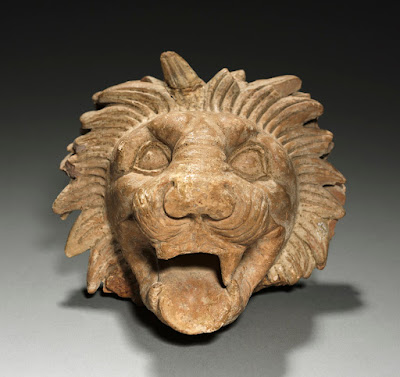 |
| Ancient Etruscan Culture Head of a Young Man 3rd century BC terracotta Hermitage, Saint Petersburg |
 |
| Ancient Greek Culture Mirror Box with Head of Athena 400-375 BC bronze Cleveland Museum of Art |
 |
| Roman Empire Bust of Diana 2nd-3rd century AD marble (heavily restored) Chrysler Museum of Art, Norfolk, Virginia |
 |
| Roman Empire Head of a Lion 3rd century AD marble (sarcophagus fragment) Philadelphia Museum of Art |
 |
| Ancient Greek Culture Head of a Lion 5th century BC terracotta Cleveland Museum of Art |
 |
| Ancient Egyptian Culture Pendant (older lion-head gaming-piece set into later baboon-base) 700 BC amethyst and gold Cleveland Museum of Art |
 |
| Ancient Greek Culture Pelike (heads of gryphon, woman and horse) 360-330 BC painted terracotta Hermitage, Saint Petersburg |
 |
| Ancient Greek Culture Head of Horse 5th century BC marble Detroit Institute of Arts |
 |
| Roman Empire Bust of Avidia Plautia (mother of Emperor Lucius Verus) AD 136-138 marble Yale University Art Gallery |
 |
| Roman Empire Head of Julia Domna (consort of Emperor Septimius Severus) AD 203-217 marble Yale University Art Gallery |
 |
| Roman Empire Head of a Woman AD 117-138 marble Princeton University Art Museum |
 |
| Roman Empire Head of a Woman AD 117-138 marble Princeton University Art Museum |
 |
| Ancient Greek Culture Head of a Woman 2nd century BC marble (colossal, heavily restored) British Museum |
 |
| Ancient Greek Culture Head of a Man 320 BC marble Walters Art Museum, Baltimore |
 |
| Roman Empire Head of a Youth (the Nelson Head) AD 150 marble Museum of Fine Arts, Boston |
 |
| Roman Empire Head of a Youth 1st century AD marble Princeton University Art Museum |
Persistences
Wind, though in the temple,
criticizes the pillars,
from bronze walls and set
floors
takes haze away, a small
flour
given back to the desert:
nuzzles into alcoves and porticoes
as if glad to
take on the curvature
and drowse
but leaks and brushes away again
restless with what
remains a while:
the theorem of the wind
no pigment, wall, or word
disproves: propositions
scatter before it,
grow up in brier thickets
and thistle thickets:
still, from our own ruins,
we thrash out the
snakes and mice,
shoo the lean ass away,
and plant a row of something:
we know,
we say to the wind, but we will
come back again and back:
in debris we make a holding as
insubstantial and permanent as mirage.
– A.R. Ammons (1978)